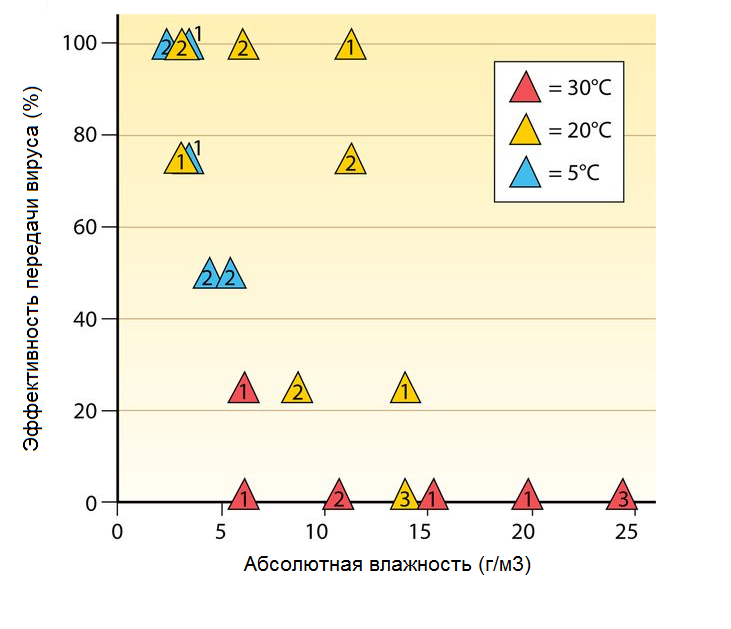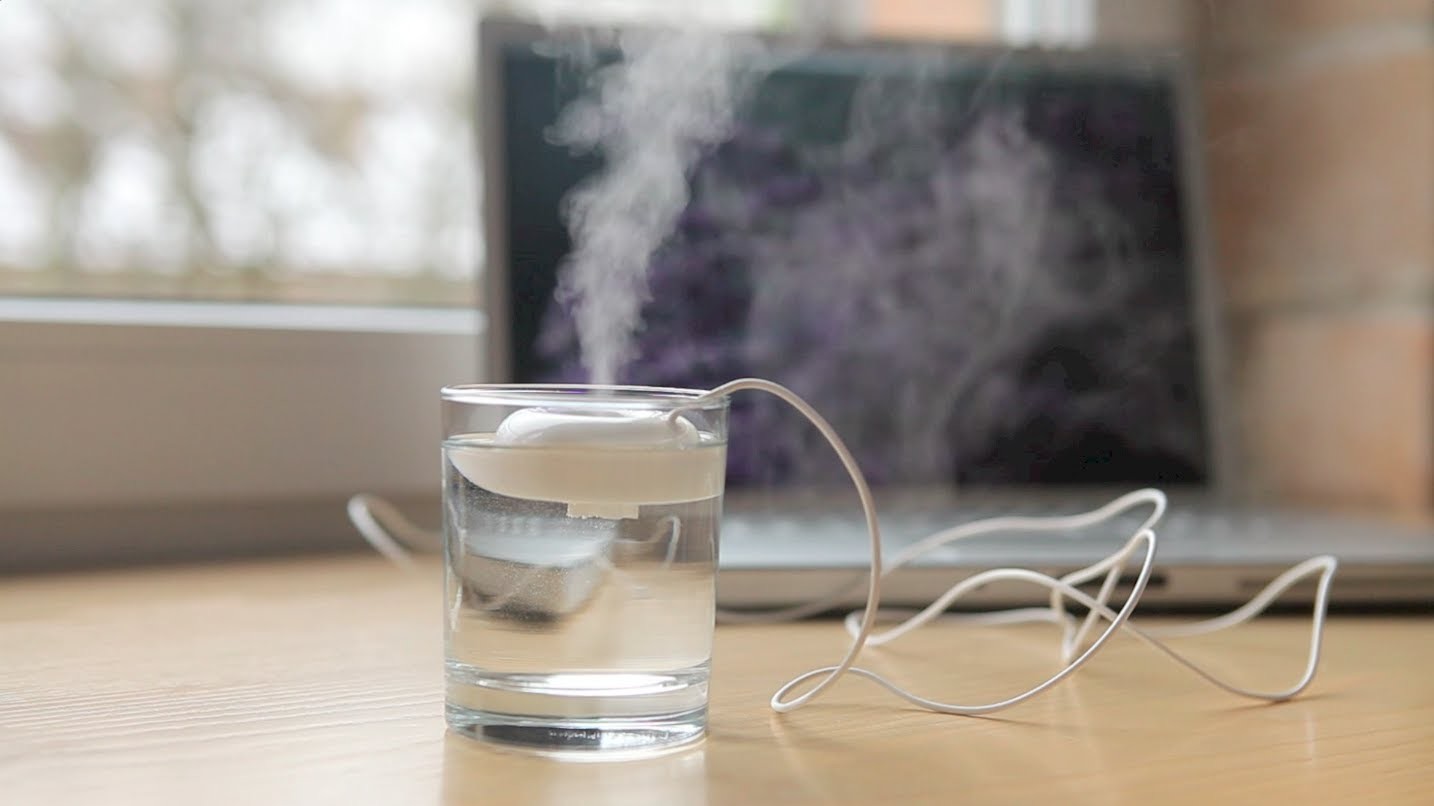Anti-flu microclimate: how to kill a virus with the help of ventilation and a humidifier
The Ministry of Health said: the swine flu epidemic in Russia is coming to an end. But due to the high variability of the influenza virus, epidemics occur every 2–3 years, and seasonal outbreaks generally occur every year. Therefore, protection of influenza is always a hot topic. Initially, we wanted to write about different technologies of air purification and their effectiveness in combating the virus. But after studying scientific articles and talking with a specialist of the center of virology and biotechnology "Vector", we realized that it is possible to destroy the flu virus without a purifier.
The main thing to follow three rules:

The good news: the flu virus is not adapted for survival in the environment. This is an intracellular parasite. Its protective lipid membrane is formed from the cytoplasmic membrane of the host cell. The owner of the flu virus is animals. Their cells, unlike the same bacteria, do not have a strong cell wall. Hence, the flu virus does not have it.
In the classification of microorganisms for resistance to chemical disinfectants, the influenza virus takes the last place: class 3, rank I. It dies even from simple antiseptics such as alcohol, hydrogen peroxide or chlorhexidine. This way you can destroy viruses that have settled on the floor, furniture, etc. And what to do with the virus in the air? It turned out there to kill him even easier.
')
The patient is a carrier of infection the day before the first symptoms of influenza and for two days after the normalization of temperature. The main route of transmission of any influenza virus is airborne. When coughing, the patient throws into the air a few hundred drops of an aerosol with a virus when sneezing - about 20,000 drops. The smallest of them (1-4 microns) hang in the air for several hours. During this time, the virus dies in the outdoor moving air, but it remains active for a long time in a room with poor ventilation.
One of the first observations describing the relationship between the work of ventilation and the rate of infection spread happened in the 1970s. Then there was a flu outbreak on board the aircraft. There was a three-hour flight delay. Most of the 54 passengers were on board, and one of them was sick with the flu. Just one source of infection was enough to cause 75% of passengers to have flu symptoms after the flight. The ventilation system in the cabin did not work. And experts quite reasonably decided that it was this that played a key role.
Later, a statistically significant relationship between the work of ventilation and infections transmitted by airborne droplets was repeatedly proved. Here is a review of some studies on this topic (the publication is closed, you can access it using Sci-Hub ).
The patient releases viral particles non-stop, so the airing should be constant. The volume of air exchange should be at least standard: for one person 30 m3 / h or more. Plastic windows in micro-ventilation mode do not provide as much fresh air. And keeping windows wide open is problematic, because flu epidemics usually occur during the cold season. Therefore, we advise to install mechanical ventilation :

Through a through channel in the wall, the inlet ventilation supplies fresh air from the street, cleans and heats it. The performance of the device is 30-120 m3 / h, depending on the selected mode of operation. This air exchange is enough to virtually no flu virus in the air.
A comparative analysis of meteorological data and pandemic influenza data showed that large outbreaks of influenza almost always coincided with a fall in the level of atmospheric humidity. Also, studies show that influenza epidemics are associated with low absolute humidity of room air. The mechanism of destruction of the virus in humid air is still not clear. But the relationship between absolute humidity and the efficiency of the spread of the influenza virus has been experimentally proven (see graph below).
Each triangle on the chart is the ratio of the efficiency of the spread of the influenza virus and absolute humidity. The color of the triangle indicates the temperature at which the tests were performed. The number in the triangle - the number of tests under these conditions.

At 30 ° C, the virus does not spread at virtually any humidity. But for most people, 30 ° C at home or at work is too hot. It is better to look at the yellow triangles, they are more consistent with a comfortable temperature in the room (20 ° C).
It is seen that at 20 ° and absolute humidity of 14 g / m3, the flu virus does not spread at all. Using an online calculator, it is easy to calculate that the absolute humidity of 14 g / m3 corresponds to a relative humidity of 80%. If the room is so humid, you can not be afraid of the flu virus. This is slightly higher than the optimal level (40-60%), but during epidemics it is better to suffer a slight waterlogging than a viral infection.
In the cold season, the relative humidity in the apartment drops to 10-20%. Folk remedies such as wet rags on the battery will not increase this figure to 80%. The only effective way to do this is to install a humidifier.

There are three main types of household humidifiers:
All types have pros and cons. When choosing a particular model should focus on performance. It should be at least 300 ml / h. Judging by the numerous reviews of real users, humidifiers with lower performance can not raise the relative humidity even to 60-70%.
To reduce the spread of influenza virus in the room, it should contain:
If there are a lot of people in the room and some of them are potentially infected with the flu (for example, in the office, children’s group or school class), an air purifier can be installed in it for additional protection against the virus. The main thing is that it should be with the HEPA filter and the function of inactivating (destroying) microorganisms on the filters.

The cleaner does not deliver fresh air from the street, but it destroys the flu viruses in the room itself. The effectiveness of air purification depends on the model. An air purifier with a HEPA filter retains more than 95% of an aerosol with viral particles. And the inactivation function does not allow the virus to remain active on the filters. The medical standard assumes the efficiency of inactivation of at least 99.9%.

The main thing to follow three rules:
- Often wipe the antiseptic hand and all the surfaces to which you touch.
- Rarely appear in crowded places: shopping centers, movie theaters, pharmacies, hospitals, etc.
- Install ventilation and air humidifier in the rooms where you are often (home, office, school, kindergarten).

The good news: the flu virus is not adapted for survival in the environment. This is an intracellular parasite. Its protective lipid membrane is formed from the cytoplasmic membrane of the host cell. The owner of the flu virus is animals. Their cells, unlike the same bacteria, do not have a strong cell wall. Hence, the flu virus does not have it.
In the classification of microorganisms for resistance to chemical disinfectants, the influenza virus takes the last place: class 3, rank I. It dies even from simple antiseptics such as alcohol, hydrogen peroxide or chlorhexidine. This way you can destroy viruses that have settled on the floor, furniture, etc. And what to do with the virus in the air? It turned out there to kill him even easier.
')
Influenza and ventilation
The patient is a carrier of infection the day before the first symptoms of influenza and for two days after the normalization of temperature. The main route of transmission of any influenza virus is airborne. When coughing, the patient throws into the air a few hundred drops of an aerosol with a virus when sneezing - about 20,000 drops. The smallest of them (1-4 microns) hang in the air for several hours. During this time, the virus dies in the outdoor moving air, but it remains active for a long time in a room with poor ventilation.
One of the first observations describing the relationship between the work of ventilation and the rate of infection spread happened in the 1970s. Then there was a flu outbreak on board the aircraft. There was a three-hour flight delay. Most of the 54 passengers were on board, and one of them was sick with the flu. Just one source of infection was enough to cause 75% of passengers to have flu symptoms after the flight. The ventilation system in the cabin did not work. And experts quite reasonably decided that it was this that played a key role.
Later, a statistically significant relationship between the work of ventilation and infections transmitted by airborne droplets was repeatedly proved. Here is a review of some studies on this topic (the publication is closed, you can access it using Sci-Hub ).
The patient releases viral particles non-stop, so the airing should be constant. The volume of air exchange should be at least standard: for one person 30 m3 / h or more. Plastic windows in micro-ventilation mode do not provide as much fresh air. And keeping windows wide open is problematic, because flu epidemics usually occur during the cold season. Therefore, we advise to install mechanical ventilation :

Through a through channel in the wall, the inlet ventilation supplies fresh air from the street, cleans and heats it. The performance of the device is 30-120 m3 / h, depending on the selected mode of operation. This air exchange is enough to virtually no flu virus in the air.
Flu and humidifier
A comparative analysis of meteorological data and pandemic influenza data showed that large outbreaks of influenza almost always coincided with a fall in the level of atmospheric humidity. Also, studies show that influenza epidemics are associated with low absolute humidity of room air. The mechanism of destruction of the virus in humid air is still not clear. But the relationship between absolute humidity and the efficiency of the spread of the influenza virus has been experimentally proven (see graph below).
Each triangle on the chart is the ratio of the efficiency of the spread of the influenza virus and absolute humidity. The color of the triangle indicates the temperature at which the tests were performed. The number in the triangle - the number of tests under these conditions.
At 30 ° C, the virus does not spread at virtually any humidity. But for most people, 30 ° C at home or at work is too hot. It is better to look at the yellow triangles, they are more consistent with a comfortable temperature in the room (20 ° C).
It is seen that at 20 ° and absolute humidity of 14 g / m3, the flu virus does not spread at all. Using an online calculator, it is easy to calculate that the absolute humidity of 14 g / m3 corresponds to a relative humidity of 80%. If the room is so humid, you can not be afraid of the flu virus. This is slightly higher than the optimal level (40-60%), but during epidemics it is better to suffer a slight waterlogging than a viral infection.
In the cold season, the relative humidity in the apartment drops to 10-20%. Folk remedies such as wet rags on the battery will not increase this figure to 80%. The only effective way to do this is to install a humidifier.

There are three main types of household humidifiers:
- Traditional
- Steam
- Ultrasound
All types have pros and cons. When choosing a particular model should focus on performance. It should be at least 300 ml / h. Judging by the numerous reviews of real users, humidifiers with lower performance can not raise the relative humidity even to 60-70%.
We summarize
To reduce the spread of influenza virus in the room, it should contain:
- Supply ventilation with a capacity of at least 30 m3 / h per person
- Air humidifier with a capacity of at least 300 ml / h
PS: about the cleaner
If there are a lot of people in the room and some of them are potentially infected with the flu (for example, in the office, children’s group or school class), an air purifier can be installed in it for additional protection against the virus. The main thing is that it should be with the HEPA filter and the function of inactivating (destroying) microorganisms on the filters.

The cleaner does not deliver fresh air from the street, but it destroys the flu viruses in the room itself. The effectiveness of air purification depends on the model. An air purifier with a HEPA filter retains more than 95% of an aerosol with viral particles. And the inactivation function does not allow the virus to remain active on the filters. The medical standard assumes the efficiency of inactivation of at least 99.9%.
Ventilate, moisten, purify the air, do not forget about the rules of prevention and personal hygiene - and any flu epidemic will pass you by. Be healthy!

Source: https://habr.com/ru/post/390781/
All Articles